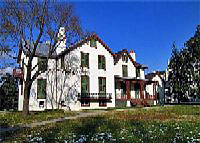
 |
| |
|
|
Lincoln Cottage Restored with Help From Save America’s TreasuresOne of the most significant, but little remembered places in the presidency of Abraham Lincoln has been restored with an award from Save America's Treasures and through the efforts of its private partner the National Trust for Historic Preservation. For more than 140 years the Lincoln Cottage, which served as a summer retreat for President Lincoln during his presidency, has been off-limits to visitors and almost forgotten, except by scholars. Today, what was once a rural residence known to Lincoln as the Solidiers Home—currently the Armed Forces Retirement Home—is tucked away in an urban neighborhood in northwest Washington, D.C. .The Lincoln Cottage now joins the rest of capital’s well known landmarks.  The newly restored Anderson Cottage served as Abraham Lincoln's summer White House. Located on the grounds of the U.S. Soldiers' and Airmen's Home, Lincoln spent one-fourth of his presidency at Soldiers' Home. Richard Moe, president of the National Trust for Historic Preservation, officially opened the restored cottage and nearby Robert H. Smith Visitor Education Center on President's Day to the public after a 10-year preservation effort and a $15 million dollar investment. Moe said in his remarks, “No other place gives us such insight into Lincoln the president and Lincoln the man… It is one of the most significant Lincoln sites outside the White House.” Restoring the cottage to the American people began with its designation as a National Monument by President Clinton in 2000, followed by a Save America's Treasures award of $750,000. These actions made it possible for the National Trust to leverage almost $10 million in private funds to transform a former administration building into a visitor education center and completely renovate the cottage to what scholars and preservationists believe it looked like during the Civil War. Additional public monies from the U.S. Congress and the National Endowment for the Humanities helped complete the project. The transformation of the cottage into a vital part of Lincoln's legacy highlights Save America's Treasures ability to catalyze a broad and exemplary public-private partnership to rescue, revive and restore the critical places and pieces of our history and culture.  Lincoln wrote the final draft of the Emancipation Proclamation while at the cottage. Adjacent to the cottage is the Robert H. Smith Visitor Education Center, which features exhibits and media presentations on the proclamation and Lincoln's presidency. Lincoln wrote his final draft of one of the nation's most significant documents here at the cottage—the Emancipation Proclamation, which declared an end to slavery in the U.S.. The words and ideas that shaped the proclamation evolved over time through his reading and discussions while Lincoln was in residence. The new education center is in part dedicated to enriching the visitor's understanding of this momentous document. This document and Lincoln's evolving views on the Civil War were all shaped by his experiences at the Soldier's Home, according Lincoln scholars. Each day he rode the three miles to and from the White House, he stopped to speak with residents, including the poet Walt Whitman, common solidiers, and former slaves. Sitting on the porch, he could see not only the Capitol, but also the daily toll of the war as solidiers were buried nearby in the national cemetary. Unlike traditional house museums, the restored Lincoln Cottage has very little in terms of furnishings. Instead, furniture, like the replica of Lincoln's desk, is used as a prop for the interpreters conducting tours of the house. Each of the pieces connects to a story about Lincoln—the ideas, events and activities that took place during his stay. This focus on engaging the imagination of visitors also embodies another purpose of the newly restored cottage and educational center—to create a forum and a place for Lincoln scholarship. The planned Center for the Study of the Lincoln Presidency will gather and disseminate scholarship related to Lincoln's presidency. For more information on the Lincoln Cottage visit their Web site.
|
|